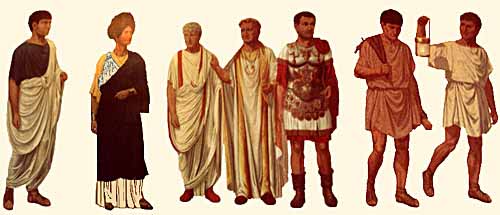

Roman dress differed from one class to another. The tunic was worn by plebians (common people), herdsmen and slaves was made from a coarse dark material. The tunic worn by patricians was made from white wool or linen. Magistrates wore the tunic augusticlavia, and senators wore a tunic with broad strips, tunica laticlavia. Military tunics were shorter than those worn by civilians.
Roman Men
Wigs were worn by men as a disguise and to hide baldness. Hairstyles and beards varied with the times. In early Roman times, men wore long hair and full beards. For a while, they were clean-shaven with short hair. About 1 Century AD, they had started to style their hair, and wear beards again.
Rings were the only jewelry worn by Roman citizen men, and good manners dictated only one ring. Of course, some men did not follow "good taste", and wore as many as sixteen rings. Most early Roman jewelry resembled Greek and Etruscan jewelry, but Roman styles eventually developed. The Romans were fond of colored stones such as topaz, emeralds, rubies and sapphires. Pendants, especially cameos in gold frames, were popular.
Metal detectorist in UK finds ancient Roman penis pendant
A metal detectorist recently discovered a silver, penis-shaped pendant in Kent, England that was likely worn around the neck to protect a person from misfortune around 1,800 years ago. Ancient Roman writers such as Marcus Terentius Varro (lived 116 B.C. to 27 B.C.) and Pliny the Elder (A.D. 23 to 79) mention how the phallus and representations of it are thought to have had the power to protect a person from evil. Many depictions of the phallus have been found throughout the Roman Empire and scholars often believe that they were created to avoid bad luck. The pendant (also called an amulet) is about 1.2 inches (3.1 centimeters) long, with a tiny ring at the top for a string (necklace) to go through. It dates back to a time when the Romans controlled England, between A.D. 42 and 410.
Wool, the most commonly used fibre, was most likely the first material to be spun. The sheep of Tarentum were renowned for the quality of their wool, although the Romans never ceased trying to optimise the quality of wool through cross-breeding. The production of linen and hemp was very similar to that of wool and was described by Pliny the Elder. After the harvest, the material would be immersed (most probably in water), it would be skinned and then aired. Once dry, the fibers would be pressed mechanically (with a mallet) and then smoothed. Following this, the materials were woven. Linen and hemp both are tough and durable materials.
Silk and cotton were imported, from China and India respectively. Silk was rare and expensive; a luxury afforded only to the richest. Due to the cost of imported clothing, quality garments were also woven from nettle.
Wild silk, that is, cocoons collected from the wild after the insect had eaten its way out, also was known. Wild silk, being of smaller lengths, had to be spun. A rare luxury cloth with a beautiful golden sheen, known as sea silk, was made from the long silky filaments or byssus produced by Pinna nobilis, a large Mediterranean seashell.
These different fibres had to be prepared in different ways. According to Forbes, their wool contained around 50% fatty impurities, flax and hemp were about 25% impure, silk was between 19 and 25% impure, while cotton (the most pure of all the source fibers) contained only 6% impurities.

The Romans had to turn their material with a manual spinner. Iron alum was used as the base fixing agent and it is known that the marine gastropod, Haustellum brandaris, was used as a red dye, due to its purple-red colorant (6,6'-dibromoindigotin); the color of the emperor. The dye was imported from Tyre, Lebanon and was used primarily by wealthy women. Cheaper versions were also produced by counterfeiters.
A more widely used tint was indigo, allowing blue or yellow shades, while madder, a dicotyledon angiosperm, produced a shade of red and was one of the cheapest dyes available. According to Pliny the Elder, a blackish color was preferred to red. Yellow, obtained from saffron, was expensive and reserved for the clothing of married women or the Vestal Virgins. There were far fewer colors than in the modern era.
Archaeological discoveries of Greek vases depict the art of weaving, while writers in the field of antiques mention the art of weaving and fibre production. Some clothes have survived for several centuries and, as clothing is necessary, examples are numerous and diverse. These materials often provide some of the most detailed and precious information on the production means used, on the dyes used, on the nature of the soil where the materials were grown and, therefore, on trade routes and climate, among many other things.
Historical research in the area of ancient clothing is very active and allows researchers to understand a great deal about the lifestyle of the Romans. The materials used were similar to those used by the ancient Greeks, except the tilling process had been ameliorated and the tilled linen and wool were of a far superior quality.
The Romans had two main ways of tanning, one of which was mineral tanning, or "tawing" - making hide into leather without the use of tanning, especially by soaking it in a solution of alum and salt. The Romans used tools that resembled those that would be used in the Middle Ages.
The tanned leather then was used to fashion heavy coats to keep Roman soldiers warm during travel, and in more frigid areas of Rome, it was used during cold seasons.
The leather was not given to the soldiers by the military commanders or overseers, but rather from the soldier's wives and family before the soldiers left for a campaign. Although leather sometimes was used for protection against poor weather, its primary use was in footwear and belts.
Animal skins were worn over the helmet with bearskins being popular among legionaries and feline among with Praetorians. Ancient Roman taxidermists would retain the entire body and the head, with the front legs tied to fasten over the armor. The animal's head would fit over the soldier's helmet, and mostly was worn by the Roman aquilifer, who carried the symbol of Rome into battle.
The Romans rarely used goatskin for their leather, preferring pig or sheepskin, although the ideal would be the preferred leather was that most readily available - cattle skin. The thickest and most durable leather was used for shoe soles - they had to be durable to endure war.
The act of putting on outer garments such as the toga or pallium, was described as amicire, which led to any individual outer garment sometimes being identified as an amictus without it being thought necessary to specify which outer garment was referred to. The equivalent term for the donning of undergarments,such as the tunica, was induere (indutus).
In general, individual clothes were woven on vertical looms during antiquity. This contrasts with the medieval period when cloth was produced on foot-powered horizontal looms that later was made into clothes by tailors. Evidence for the transition between these two distinct systems, from Egypt, suggests that it had begun by 298 AD but it is likely that it was very gradual. The weaver sat at the horizontal loom producing rectangular lengths of cloth which never were wider than the weaver's two arms could reach with the shuttle. Conversely, a weaver who stood at a vertical loom could weave cloth of a greater width than was possible sitting down, including the toga, which could, and did, have a complex shape.
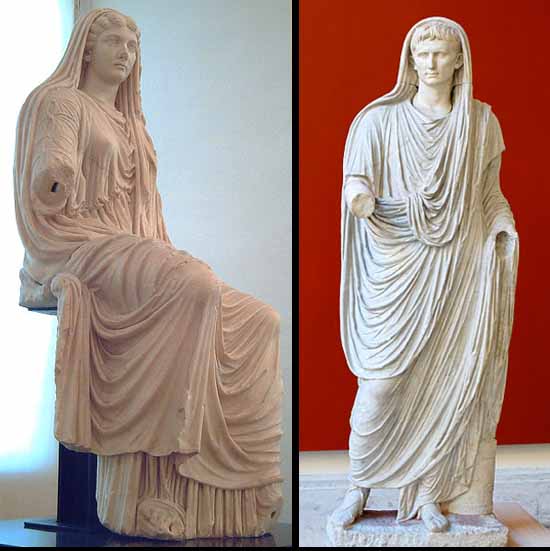
The variations of clothing worn in Rome were similar to the clothing worn in Greece at the same time, with the exception of the traditionally Roman toga. Until the 2nd century BC, the toga was worn by both genders and bore no distinction of rank - after that, a woman wearing a toga was marked out as a prostitute. The differentiation between rich and poor was made through the quality of the material; the upper-classes wore thin, naturally colored, wool togas while the lower-classes wore coarse material or thin felt. They also differentiated by colors used:
the toga picta or toga palmata, with a gold border, used by generals in their triumphs
trabea - toga entirely in purple, worn by statues of deities and emperors
saffron toga - worn by augurs and priestesses, white with a purple band, also worn by consuls on public festivals and equites during a transvectio
Red Borders - worn by men and women for festivals

A Roman could tell how important or wealthy a person was from their toga. Free Roman men wore the toga instead of a cloak. It was originally an Etruscan garment worn in earlier times by both men and women of all classes. The toga was made from white wool or white Egyptian linen. It was square or rectangular in shape and was worn draped around the body.
The toga was worn often during state occasions. Consuls and senators wore a toga edged with purple. Some Roman senators wore white tigas that were ten meters long. Some emperors' togas were made entirely from either purple or black cloth. Black togas, though, were usually only worn in times of mourning.
Togas looked like a white sheet 9 yards long. They were arranged very carefully, in a stylish way. Togas fell out of style rather early. (The toga was inconvenient, and people felt the cold when they wore it.) To get anyone to wear them, even very early emperors had to legislate the wearing of togas by at least senators. Eventually, the emperors gave up.
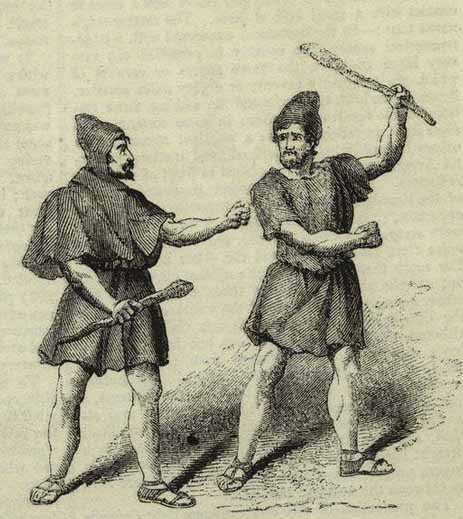
The Romans switched to comfortable tunics, which looked like long tee-shirts. They were far more practical. Tunics were made of cool linen, for summer wear, and warm wool, for winter wear. Sometimes, they worn trouser like garments.
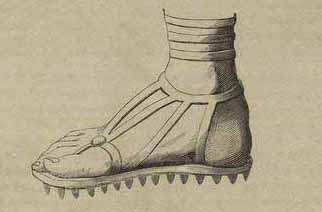
Footwear also defined a person's position in society. Women wore closed shoes that were either white, green or yellow. Men wore sandals. Patricians wore red sandals with an ornament at the back. Senators wore brown footwear with black straps which wound round the leg to mid-calf, where the straps were tied. Consuls wore white shoes, and soldiers, heavy boots.
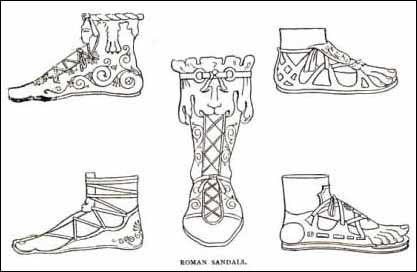
Gladiators Sandals
8 ancient Roman shoes of 'exceptional size' discovered at Roman fort near Hadrian's Wall Live Science - July 4, 2025
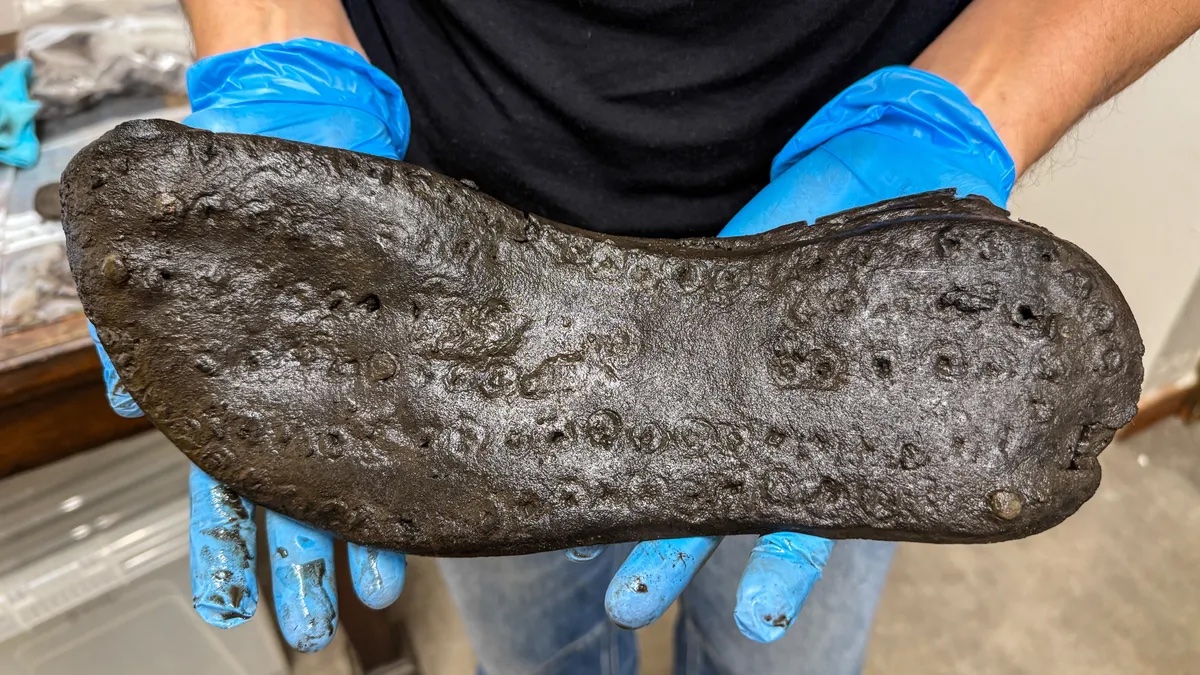
Ancient Roman Bigfoot? 'Unusually Large' Shoes Puzzle Archaeologists Science Alert - July 4, 2025
A stash of "unusually large" 2,000-year-old shoes dug up at a Roman site in northern England has left archaeologists searching for an explanation
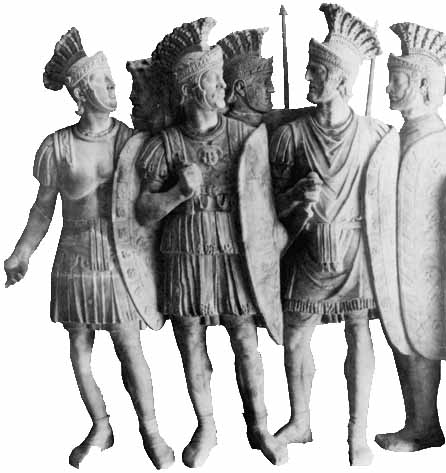
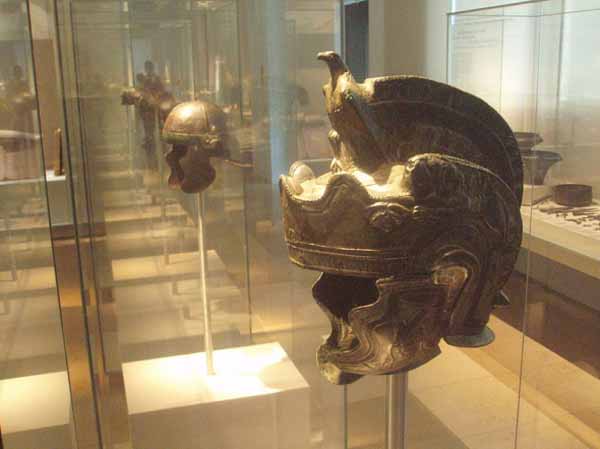
It's interesting to note that most Roman armor probably did not shine. They used a lot of chain mail (a sort of cloth made of circular links), which doesn't shine. They also made scale armor (metal plates about 3 inches long and about an inch wide, sewn together on a linen/leather backing.) Scale armor shines a little, but not much. And, they made leather armor, with the metal on the inside, or at least under the leather, probably again on a backing of linen, to make three layers. So, although the ancient Romans loved the ornate and glittery, their armor most probably did not shine!
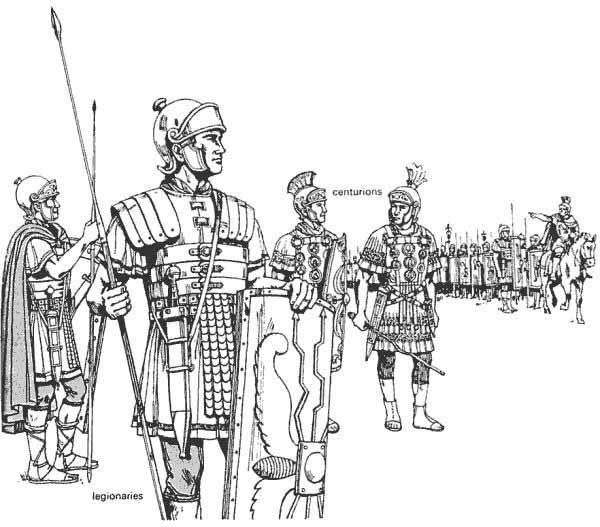
Roman Military
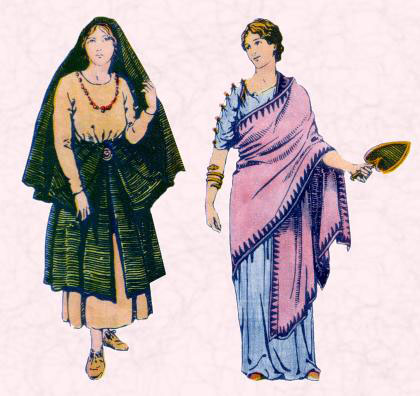
After the 2nd century BC, besides tunics, women wore a simple garment known as a stola and usually followed the fashions of their Greek contemporaries. Stolae typically comprised two rectangular segments of cloth joined at the side by fibulae and buttons in a manner allowing the garment to drape freely over the front of the wearer. Over the stola, women often wore the palla, a sort of shawl made of an oblong piece of material that could be worn as a coat, with or without hood, or draped over the left shoulder, under the right arm, and then over the left arm. The palla covered the respectable matron when she went outside. It is often described as a cloak.
Women wore a tunica which was adapted from the Greek chiton. The tunica was usually knee-length. Over this the women wore a stola which was a full length from neck to ankle, high- waisted and fastened at the shoulders with clasps. The stola was usually either white, brown or grey, though some were brightly colored with vegetable dyes. A shawl, called a palla, was worn wrapped around the shoulders and arm, or could be draped over the head. Cloaks were worn to keep warm.
Hats were not worn except by slaves but women were expected to cover their heads when walking outdoors.
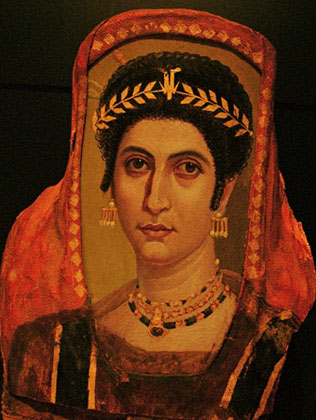
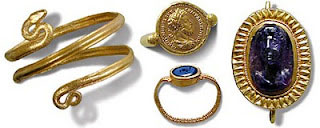
Women enjoyed gazing at themselves in mirrors of highly polished metal (not glass). The ancient Roman women loved ornate necklaces, pins, earrings, bracelets and friendship rings. Pearls were favorites. Women often dyed their hair, usually golden-red.
Black obsidian mirrors were also used by oracles in a form of divination called mirror scrying
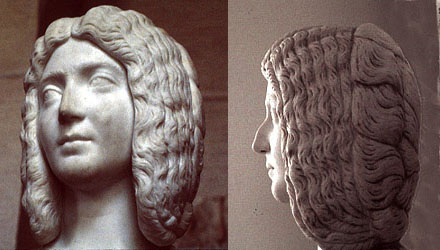
They used false hairpieces to make their hair thicker or longer. Sometimes, Roman women wore their hair up, in carefully arranged styles, held with jeweled hairpins. Sometimes they wore it down, curled in ringlets. Fashionable women wore hair-pieces that were often made from the hair of slave girls.
Parasols were used, or women might carry fans made of peacock feathers, wood or stretched linen. Women's street shoes were made of leather, like a man's. In the house, most Romans (men and women) wore sandals. Women's sandals were brightly colored. Some were even decorated with pearls.
Chalk powder, charcoal and saffron were used as cosmetics.
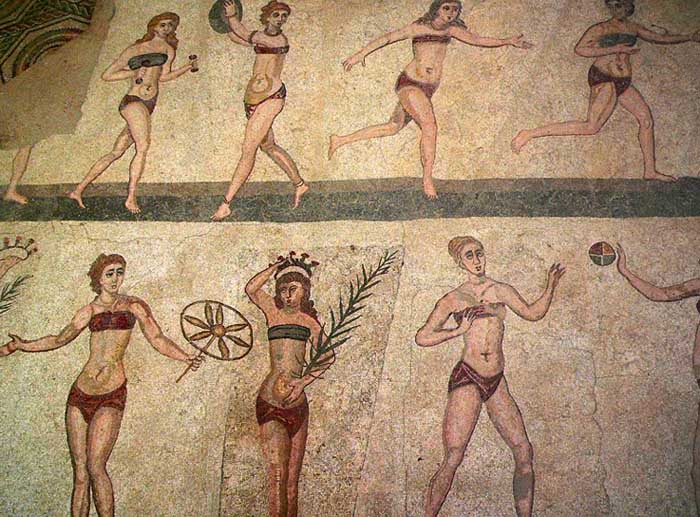
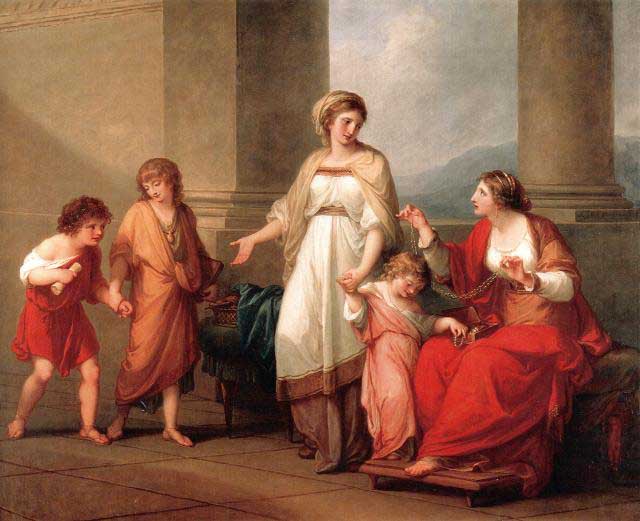
Girls wore a simple tunic with a belt at the waist. When they went outside, they wore a second tunic that reached their feet.
Boys wore a tunic down to their knees. It was white, with a crimson border. Once a boy became a man, he put aside his childish clothes, and wore an all-white tunic. A boy became a citizen at age 16 or 17. The year was selected by choosing the date which came closest to March 17th. Coming of age, becoming a citizen, was quite a celebration. On a boy's sixteenth or seventeenth birthday, the boy dressed himself in a white tunic, which his father adjusted. The day ended with a dinner party, given by the father, in honor of the new Roman citizen.
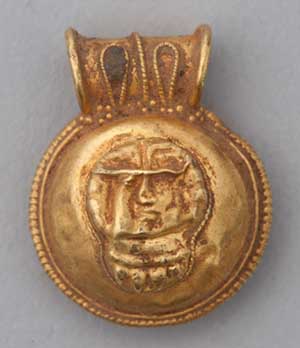
Children wore a special locket around their neck, given to them at birth, called a bulla. It contained an amulet as a protection against evil and was worn on a chain, cord, or strap. Girls wore their bulla until the eve of their wedding day, when their bulla was set aside with other childhood things, like her toys. Boys wore their bulla until they day they became a citizen. Boys bullas were put aside and carefully saved. A boy's bulla could be wore by the owner again, if he won special honors. For example, if he became a successful general, and won the honor of triumph, he would wear his bulla in ceremonial parades, to protect him from the evil jealously of men or gods. Roman girls often wore nothing more than a tunic hanging below the knees or lower, belted at the waist and very simply decorated, most often white. When a girl went out she sometimes wore another tunic, longer than the first, sometimes to the ankles or even the feet.
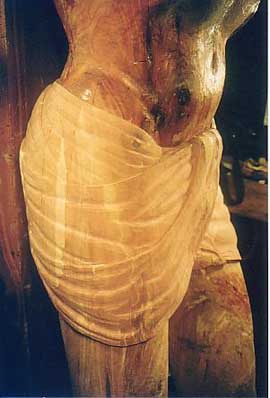
Loincloth
The basic garment for both sexes, often worn beneath one or more additional layers, was the loincloth, tunica or tunic. This was a simple rectangle sewn into a tubular shape and pinned around the shoulders like a Greek chiton. Women might also wear a strophium or breast cloth. Garments to cover the loins, known as subligacula or subligaria, might also be worn, especially by soldiers. The Vindolanda tablets found in Great Britain confirm this fashion at the time of the Roman Empire, when a subligaculum might be made of leather. Farm workers wore loincloths.
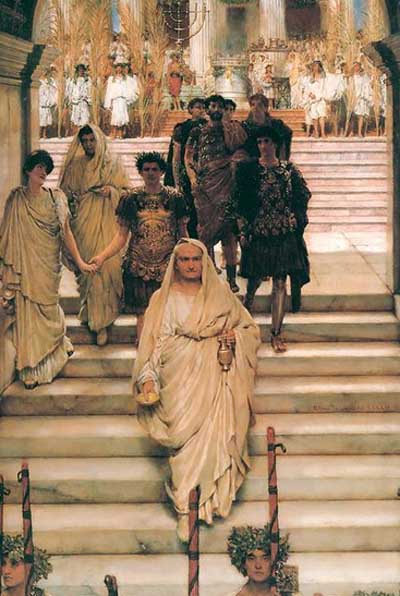
The dress code of the day was complex and had to reflect one's position accurately in the social order, one's gender, and one's language.
laena - worn by the king and the flamens at sacrifices
crocota - saffron robe worn by women during ceremonies to Cybele
Roman fashions underwent very gradual change from the late Republic to the end of the Western empire, 600 years later. In the later empire after Diocletian's reforms, clothing worn by soldiers and non-military government bureaucrats became highly decorated, with woven or embellished strips, clavi, and circular roundels, orbiculi, added to tunics and cloaks. These decorative elements usually comprised geometrical patterns and stylized plant motifs, but could include human or animal figures.
The use of silk also increased steadily and most courtiers in late antiquity wore elaborate silk robes. Heavy military-style belts were worn by bureaucrats as well as soldiers, revealing the general militarization of late Roman government. Trousers - considered barbarous garments worn by Germans and Persians - achieved only limited popularity in the latter days of the empire, and were regarded by conservatives as a sign of cultural decay. In early medieval Europe, kings and aristocrats dressed like late Roman generals, not like the older toga-clad senatorial tradition.
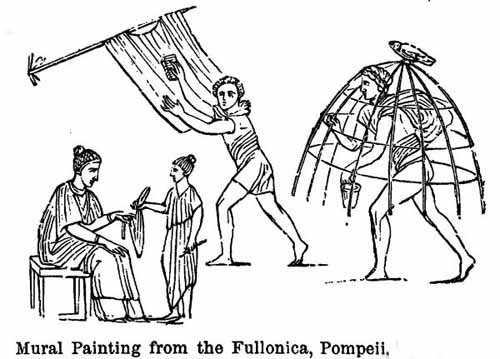
Cleaning clothes at home was difficult because of the lack of water and cleaning equipment. The task of cleaning clothes was left to fullers, who are shown in wall paintings treading clothes with their feet. Clothes were also treated with Sulphur and urine, and brushed with combs.
As you can imagine, cleaning clothes in Roman times was not like it is today. Romans didn't even have washboards which were invented much later. They must have had clotheslines or some other form of outdoor clothes dryer. The Romans certainly didn't have the resources we have today.